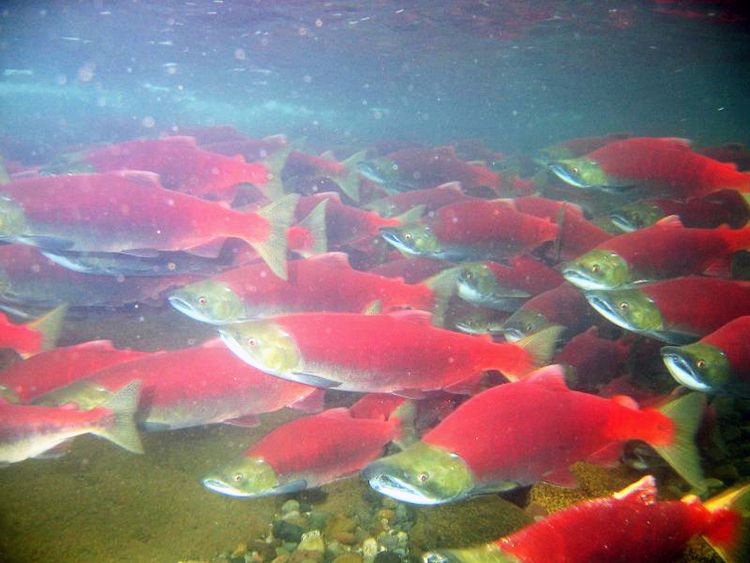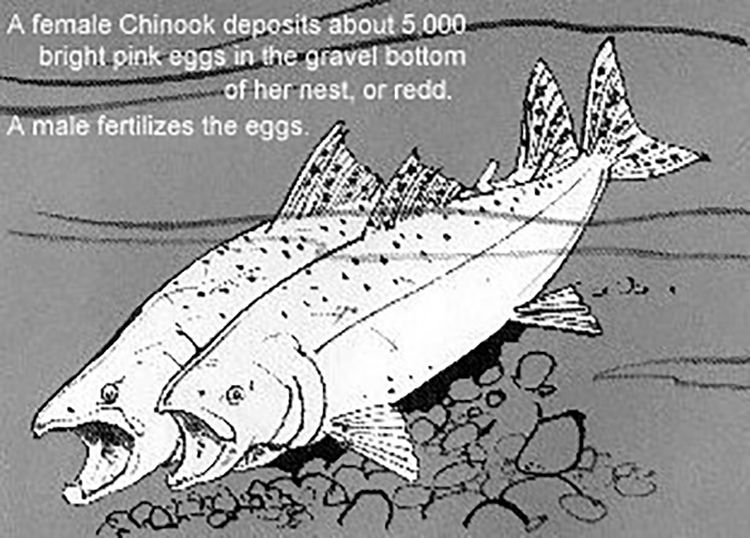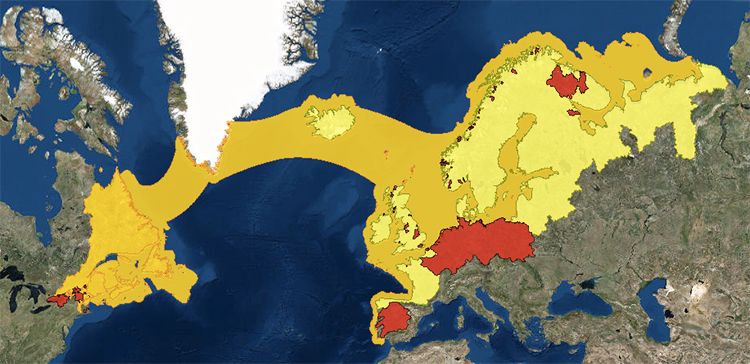
Atlantic Salmon Is All But Extinct as a Genetically Eroded Version of Farmed Salmon Has Taken Over

Atlantic salmon, the native salmon that used to inhabit the northern Atlantic Ocean, rivers and seas, is a species now represented by an impostor: farmed salmon. Also known as cultured salmon, farmed salmon comes from hatchery genetic stock and unlike its native ancestors, lacks wild genetic variation. The wild fish our ancestors ate is gone. What appears on our dinner plates is a substitute copy, a genetic dilution of a once mighty fish, the adaptive king of the sea and a significant food for coastal humans since prehistoric times.
The change in genetic stock has been happening for decades, as farmed salmon are released into native waters via restocking programs (in an attempt to reduce the negative impacts of overfishing of wild salmon) and also unintentionally as a consequence of faulty containment in sea net-cages. The resulting “swamping out” effect—farmed in, wild out—along with several other insidious factors, has driven native salmon to effective extinction.
Genetic Erosion
When I began to research the scientific literature on native Atlantic salmon, I was stunned to discover that this species (Salmo salar L.) is essentially extinct. How can this be possible? Is the fish before our eyes and on our platters not real? Yes, indeed it is, but the verified statistic is that 99.5 percent of all Atlantic salmon living today, whether farmed or fished from open ocean or rivers, is not what biologists call “wild type” and does not faithfully represent, in a genetic sense, the native fish that once broadly populated waters of our planet’s Holarctic zone, the ecological region that encompasses the majority of habitats found across the Earth’s northern continents.
The fish we eat today is not the fish that fed our ancestors or even the fish that fed our forebears of a century ago. Today’s salmon, because of the effects of a force called genetic erosion, is the diluted copy of a fish that once thrived on a wild genome, that tried and true set of original genes which, in the case of salmon, generated a fish capable of magnetic field navigation, survival in fresh and salt water and geochemical detection of spawning micro-habitats.
Genetic erosion, simply defined as the loss of genetic diversity over time, eliminates the potential of a species to adapt to new environments and leads to extinction. The swamping-out effect by farmed salmon has been one eroding genetic force working against wild salmon. We human predators have overfished, toxically farmed, illiterately stocked, dammed and blindly released, by millions, farmed and unfit Atlantic salmon fishes into the wild. The hatchery stock has bred with and overrun the native species, one that had been evolving for hundreds of thousands of years and which is now genetically eliminated, all in the quick human feeding frenzy of the last century.
In visual terms, the force of this steep genetic erosion has clear cut to an industrial hedge and burned to the biological bones, a body of irreplaceable, adaptive genetic material equivalent to a massive, old-growth forest, one which had stood for millennia over the entire Holarctic region of Earth and which is frankly not restorable. One could say that the old-growth forest of Atlantic salmon is dead.
This is not an easy tale to tell. The salmon, however, is an able storyteller, being a familiar and marvelous fish. Salmon is anadromous, a migrant from fresh water to salty sea, a fish who returns to its birth river to spawn in the family niche for the next generation, for the continuation of each clan, the many clans for each population and the many populations for each species.
Technically, the only way to explain why the salmon you think you are eating is extinct is through the lens of population and molecular genetics. Yet, the salmon is truly a salmon of knowledge and can tell its story in many ways, being a once highly diverse and differentiated, smartly pedigreed family of kin and clan. If you can follow maps and glaciations, rivers and open seas, then you can follow the clans of salmon and their ancestral family trees and the recent loss of their protective, genetic canopy.
Salmonid Evolution
The earliest salmon came from a diverse group of ocean vertebrates known as the ray-finned fishes and was part of a broad divergence of ocean fishes that adapted over eons to the cold, northern waters of the upper Northern Hemisphere, around the Arctic Circle. Early Atlantic and Pacific salmonid ancestors branched into separate ocean groups of early species types about 600,000 years ago.
Well before the coming of its most evolved predator, Homo sapiens sapiens, before the industrial degradation of the earth’s ecosystems, before and after the last retreat of the Last Glacial Maximum, salmon prospered, undisturbed and free to navigate the seas and inland rivers. The females raked their redds (spawning nests), the males attended, their black-eyed eggs developed. They grew into spotted fry, then young parr (juveniles) camouflaged in lines matured to silver-scaled adults, who when ready put out to sea to amass body weight as they navigated the ocean using the Earth’s magnetic fields to guide them.
Consistently, the salmon returned upriver to breed again, homing back to their place of ancestry, their birth location, not only to pass down the best surviving, evolutionary genetic lines, but the unique adaptive differences of their clan, which allowed them to detect, recall and locate that singular family place as being their own. Innumerable salmon clans eventually earmarked to all of the available niches within the species’ final broad biogeographical distribution.
On their way, during their travels, over time and in prehistory, salmon differentiated. Individuals of each clan began to accumulate small genetic differences by random chance, breeding and keeping those differences unto themselves and their families. Salmon clans became unique within their family’s geographic niche because they spawned among their own. The clans grew and multiplied, each clan at its own location, spreading and creating more clans, larger and more diverse populations, accumulating more of those familial differences.
Clan-genetic differentiation can now be measured by DNA fingerprinting, has been shown to correlate to geographical breeding location and, most importantly, became locally adaptive. Salmon evolved to cull the identity by smell of their home waters in the elegant genetic processes of gene co-adaptation and where the salmon bred was where the salmon was most fit. Dynasties of ecological fitness, each clan best suited to its own specific breeding location, certainly emerged.
Surviving a Frozen World
We know that the ancient, wild Atlantic salmon faced and survived Holarctic glaciation, for their genes also left a fingerprint of their biological survival gear in their molecular patterns. Well studied in northern Europe, there likely existed one or more refugia under the Weichlesian glacial plates, bodies of fresh water in which the prehistoric salmon survived as the rest of its world froze over, unable to migrate to sea.
Isolated in its clans, separated by distance and geological formations, in different rivers, breeding with no outsiders and accumulating differences, the ever-adaptable wild salmon colonies were yet diverse enough to self-populate over long periods of time, being naturally fit and self-sustaining. Meanwhile, saltwater clans were successfully breeding in the ocean. As the glaciers remained, the separated salmon clans accumulated and passed on those unique fitness differences for best survival in their different environments.
Then the glacial ice retreated upon the warming Holocene, about 12,000 years ago. The oceans rose and fingered inland into fjords and rivers as glaciers melted and individuals from refuge salmon clans began to spread into fresh territory. Some pioneered the newly opened, post-glacial rivers, challenging distance and falls, spawning further upstream again and again, as the case may be, until all of the available rivers of the north Atlantic islands, eastern Russia, the Baltic Sea and their appurtenant inland flows were filled with unique, wild salmon, a literal natural spectrum of glorious natural diversity.
In the lands abutting the northeastern Atlantic Ocean, this distribution and range included every river in and out of the sea coasts from the north of Spain to the Arctic latitudes and in North America from the Connecticut River northward. Here lived and bred the “wild type” Atlantic salmon, adaptive king of the sea and the “leaper,” the muscled fish of power, grace and fortitude. Meanwhile, our own species experienced an upturn during the advent of agriculture, about 10,000 years ago and spread around the globe. As far as the wild salmon was concerned, all was kept in checks and balances until our epoch of genetic erosion, the superseding Anthropocene, which began c. 1950. Ours is an historic epoch physically characterized by the plastic geological layer now forming as a permanent record in the crust of human industrial ways.
Today’s Salmon
The salmon has taken a fatal series of genetic blows. Its “old growth forest” was set on fire by a human feeding frenzy that began with overfishing and was fed by industrial aquaculture. The genetic erosion is shocking and steep.
Today, 99.5 percent of all native Atlantic salmon has disappeared from the wild. In Europe, Scandinavia and around the Baltic Sea, native indigenous salmon has vanished from the Russian rivers Neva and Narva, the Luleälven and Umeälven of Sweden, from the Odra and Wisla in Poland and the Vilia of Belarus. In fact, only 10 of the many rivers which empty into the Baltic arm of the northern Atlantic Ocean sustain wild salmon populations any longer and the wild Baltic salmon genome is the only one with natural resistance to the destructive Gyrodactulus salaris parasite.
Around the British Isles, in Ireland and across the pond to North America, wild salmon populations are extinct or endangered or threatened. The Kola Peninsula of Russia is known to be a current refuge for wild type Atlantic salmon, yet is also known to harbor military and radioactive waste at ecologically harmful levels. The grand Torneälven of Sweden, called Tornionjoki where it traverses Finland, is one of the last rivers to host wild Atlantic salmon in the world. (For more on the status of Atlantic salmon, see the International Union for Conservation of Nature Red List map. Researchers at the Swedish Agency for Marine and Water Management have produced a report on the Baltic extinctions. Anna Tonteri, a conservation geneticist at the University of Turku in Finland has written an excellent doctoral thesis about the population genetics of north European Atlantic salmon).
The Baltic salmon extinctions were largely enabled by human destruction of migration routes for spawning, upon the building and operation of hydroelectric dams. Further molecular DNA studies of the hatchery stock salmon from this exemplary sea have demonstrated a genetic “homogenization.” Stock salmon populations constitute more of a weak puree than a chunky soup, in terms of “population genetic structure,” another statistical measure of diversity. This is why—although the map above may demonstrate a wide range and lesser areas of extinction—the actual number of wild salmon living within the extant areas is quite small at around 0.5 percent. In other words, the orange areas showing extant salmon are overall 99.5 percent inhabited by farmed stock salmon.
We have learned to overlay DNA diversity upon geography and geologic history, in a relatively new field called landscape genomics. The important data is not just in the map or the numbers of fish, but in the genetic quality and the relationships of the individual salmon that comprise the families, clans and populations. An apparent abundance by numbers does not mean a population is healthy, self-sustaining and diverse.
In Ireland, the release of farmed salmon has not only caused genetic erosion, but has disrupted the capacity of wild populations to adapt to warmer waters. This is a problem for salmon across its geographical range for the obvious reason of climate change. Strong and well founded recommendations for saving the remaining wild salmon include cessation of stock salmon releases and re-establishment of native spawning grounds. The future effects of warming waters, however, are unknown and not hopeful.
I can tell you a similar story about the Pacific salmon, the Oncorhynchusspecies—the chum, coho, sockeye and Chinook salmon—which are also extinct or endangered or threatened and which are also genetically eroded. The destruction of the 10-million-a-year run of wild salmon on the Columbia River is unfortunately historic. The Pacific salmon had populated its portion of the Holarctic range simultaneously with the Atlantic salmon. Recent research has verified that Pacific hatchery stock salmon differs genetically from wild salmon and does so from the first generation of breeding. More than 700 genes, according to the data, were associated with “wound healing, immunity and metabolism.” (Scientists at Oregon State University recently conducted a study published in the journal Nature that shows there is DNA evidence that salmon hatcheries cause significant and rapid genetic changes). The fish are raised in overcrowded, concrete tanks, eat an artificial, supplemented diet and live in polluted water that is released into the environment whether farmed inland or off coast.
Genetic variation is the key to survival. With variation, if the environment changes, those individuals with the right variation in their genes will be most able to survive, to adapt and to regenerate a population. That is why it is important to sustain a lot of different, varied individuals in the population, in the clan, in the tribe. Genetic diversity for living organisms is the biological foundation for long term survival, for adaptation to environmental changes and is essential to species for sustaining fit populations for future generations. Genetic diversity is essential for all life on earth to survive climate changes.
The old-growth forest of Atlantic salmon was the entire set of all native salmon genes required for response and adaptation to new environments, the genetic set encompassing all salmon diversity, before the beginning of overfishing and the industrial era of H. sapiens sapiens. This forest of genetic diversity stood, so to speak, in wild swimming, individual, native salmon genomes (not laboratories!) and was acquired over millennia of biological and environmental changes by natural selection. The old-growth forest contained the wild genes of each fish, a reliable molecular network, co-adapted, set like jewels in a biological filigree, fitness genes in a pedigree of clans that salmon had naturally conserved among themselves, to sustain themselves and to protect their own kind from and for environmental changes and to adapt, to diverge and to explore new places in their niches of the living ecosystem of our planet. The old-growth forest was everything genetically needed for wild salmon survival.
Stock salmon cannot survive without human intervention. The overcrowded hatchery conditions in which it grows cause numerous fish body abnormalities and require nutritional supplementation to cover for shortfalls in bone development and other physiological problems.
Protect Whatever Remains
Human cultures rose around the salmon, which has fed and continues to feed a lot of people. In the wild, its orange flesh color comes from its consumption of shrimp and krill and the absorption of these carotenoids into its tissues. These natural pigments may actually have a protective effect for the salmon, as well as nutritional value for its consumers, humans and bears alike. Pellet-fed, farmed salmon must be supplemented to obtain its pink color.
Native, indigenous, wild Atlantic salmon, its distinguished clans and tribes, did not need human help to survive and yet we have lost the salmon to our anthropogenic ways, to overfishing, fish farming, dam construction, inbreeding, poor stock management and environmental degradation. And from these genetically eroded hills has been created a hatchery-dependent, diluted salmon, an inflexible, non-diverse and certainly not wild, genetic copy of salmon that we fish, farm, release and eat and even feed to our pets every day.
More than 99 percent of Atlantic salmon, Salmo salar L., live only as genetically eroded, hatchery stock fish today. That is a most sobering statistic considering the engineering of the Pacific Chinook salmon growth hormone into the Atlantic salmon genome (see my earlier article here). Whatever remnants still exist of our wild salmon populations must be protected without exception, especially given the potential introduction of a new, genetically engineered salmon to our frankly fragile food web.
Moreover, the pollution and operation of inland fish tanks is costly. At this point in the Anthropocene, conservation interests may want to rise up another step against the introduction of industrialized, non-native food species (call them what you will) into the only biosphere we have in which to live, until we are able to halt any further species genetic erosion. Salmon has been swimming upstream against the depleting force of “genetic erosion” for at least a century, a force that has claimed its wild genome, its clans and its tribes, its genetic diversity and which has nearly eliminated a once self-sustaining, powerful ocean species. Now, salmon cannot live without us.
Atlantic salmon is essentially extinct because we have demanded too much of this natural resource through over-consumption and environmental exploitation. The wild gene forest that once lived, the old trees, the towering antiquarians of genetic variation, are gone, lost in the fire of a rapid, wholesale, industrial Homo sapiens taking, consumed in an anthropocentric fire we could even see burning, when one looks at the timeline of scientific data.

 233k
233k  41k
41k  Subscribe
Subscribe 



